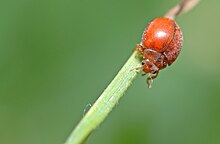User:Dluogs/sandbox
Sarah's page for notes and drafts
Useful links[edit]
Wikipedia:Picture_tutorial; Commons:Contributing_your_own_work
Wikipedia:WikiProject_Plants/Template Good plant articles: Ailanthus altissima, Verbascum thapsus, with footnotes - Adenanthos cuneatus
Wikipedia:WikiProject_Insects and Wikipedia:WikiProject_Council/Directory and Wikipedia:WikiProject Tree of Life
Wikipedia:Citing_sources, Help:Citation_Style_1, Wikipedia:Citation_templates Wikipedia:Referencing_for_beginners & Harvard_referencing Example: Harriet Arbuthnot (old)
http://de.wikipedia.org/wiki/Kleine_Keilfleckschwebfliege
To Do[edit]
Pages on Apion (weevil) and Apionidae (family of weevils) needed. Stubs would help.
Repair link: Harvard_style
University of Leeds Library (2009). "References and citations explained", accessed 25 October 2010.
http://library.leeds.ac.uk/skills-referencing , accessed 7 May 2012.
Photo use request for Przevalski's Finch to http://johnjemi.blogspot.co.uk/2007/09/urocynchramus-pylzowi.html - one day when I'm brave enough!
Red-headed Cardinal Beetle page to add. Inc. links to Cardinal Beetle
Link to pictures of http://mothphotographersgroup.msstate.edu/species.php?hodges=17 Acanthopteroctetes unifascia, as none of the moths in its Infraorder are illustrated.
Link to Phratora vulgatissima and Anthocoris nemorum from Salix cinerea page.
Bugle disambiguation - Ajuga reptans
Links to species of Gorse pests on page https://en.wikipedia.org/wiki/Biological_control_of_gorse_in_New_Zealand
Books & websites for References[edit]
- Clayton, W.D., M.S. Vorontsova, K.T. Harman and H. Williamson (2006 onwards), "Briza media" in GrassBase - The Online World Grass Flora. Retrieved 23 May 2012.
- Hubbard, C.E. (1968, 2nd Ed.) Grasses: a Guide to their Structure, Identification, Uses and Distribution in the British Isles, Harmondsworth: Penguin, p. 210-215.
- Rose, Francis (2006) The Wild Flower Key (edition revised and expanded by Clare O'Reilly) London: Frederick Warne ISBN 0-7232-5175-4
Note - from Amazon, not own copy. Double check!
- Chinery, Michael (2007 - 2nd Revised Edition) Insects of Britain and Western Europe (Domino Field Guide) London: A & C Black ISBN 0-7136-7239-0. A revision and reprint of the Collins Field Guide.
- Chinery, Michael (2009) British Insects: A photographic guide to every common species (Collins Complete Guide) London: Harper Collins ISBN 0-0072-9899-4
Page on Gooden's Nomad Bee[edit]
http://de.wikipedia.org/wiki/Nomada_goodeniana http://nl.wikipedia.org/wiki/Smalbandwespbij http://commons.wikimedia.org/wiki/File:Nomada_goodeniana_m5.JPG http://commons.wikimedia.org/wiki/Category:Nomada_goodeniana
Page on 24-spot Ladybird[edit]
Subcoccinella vigintiquatuorpunctata
Great to have a page live!!!
Description[edit]
The mandibles (jaws) of the 24-spot each have six teeth rather to help them graze leaves rather than the one or two typical of aphid eaters.NOTE
Adult beetles[edit]
 |
 |
Juvenile stages[edit]
 |
 |
 |
Distribution and Habitat[edit]
This ladybird is an Old World species occurring across Europe. It ranges south into parts of north Africa and eastwards through northern Asia excluding China.[1] It was introduced into North America some time last century with the first records from Pennsylvania in 1972.[2] In the Britain it is more common in the south.[3]
Habitat - still to do. Don't forget to correct section title on page...
Behaviour[edit]
Temporary notes[edit]
To Do: Correct date format errors in refs. 11 Jan 2014 is OK MOS:DATEFORMAT#Dates_and_years
German page: Vierundzwanzigpunkt
24-pointed Ladybird Beetle (EOL Common Name)
Book template Cite error: The <ref> tag has too many names (see the help page).
Wingless alt wording: Many 24-spot ladybirds are wingless and unable to fly, there being no hind wings for flying although the modified forewings that form the wing cases (elytra) are still present. A recent study predicts that flightlessness is increasing, with some populations including no winged individuals.[4]
References[edit]
- ^ "ITIS Report: Subcoccinella vigintiquatuorpunctata". Retrieved 13Jan2014.
{{cite web}}: Check date values in:|accessdate=(help) - ^ Wheeler, A. G. Jr. (1993). "Subcoccinella vigintiqualuorpunclala (L.), First Virginia Record and New North American Host of an Adventive Lady Beetle (Coleoptera: Coccinellidae)" (PDF). Banisteria (2). Virginia Natural History Society: 22. Retrieved 13Jan2014.
{{cite journal}}: Check date values in:|accessdate=(help) - ^ "NBN Grid map - Subcoccinella vigintiquattuorpunctata". UK: NBN - National Biodiversity Network. Retrieved 13Jan2014.
{{cite web}}: Check date values in:|accessdate=(help) - ^ Baldwin, A. J. (1990). "Further biological observations on Subcoccinella vigintiquattuorpunctata". Entomologist's Monthly Magazine. 126 (No. 1516-1519): 223–229. Retrieved 11/1/14.
{{cite journal}}:|issue=has extra text (help); Check date values in:|accessdate=(help)
Links[edit]
- i at Fauna Europaea
- The Watford Coleoptera Group - Subcoccinella vigintiquattuorpunctata
- Fauna Europaea
- [1]
- "Subcoccinella vigintiquattuorpunctata". The Watford Coleoptera Group. Retrieved 2014-01-10.
- Book template

